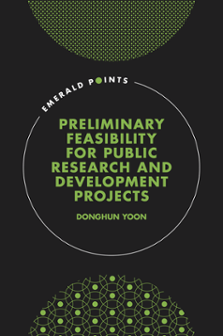
Index
Preliminary Feasibility for Public Research and Development Projects
ISBN: 978-1-80117-267-7, eISBN: 978-1-80117-266-0
Publication date: 27 April 2021
Citation
Yoon, D. (2021), "Index", Preliminary Feasibility for Public Research and Development Projects, Emerald Publishing Limited, Leeds, pp. 99-102. https://doi.org/10.1108/978-1-80117-266-020211038
Publisher
:Emerald Publishing Limited
Copyright © 2021 by Emerald Publishing Limited
INDEX
- Prelims
- Chapter 1 Introduction – R&D and R&D Budget
- Chapter 2 Government R&D Project
- Chapter 3 Technology Innovation and Government
- Chapter 4 Public Decision-making and Policy Analysis
- Chapter 5 Public Investment Analysis and Theoretical Debate
- Chapter 6 Social Discount Rate
- Chapter 7 Global Sensation
- Chapter 8 Preliminary Feasibility Study Trend
- Chapter 9 Discussing the Role of Policy Analysis in Preliminary Feasibility Study
- Chapter 10 Economic Feasibility Analysis Model
- Chapter 11 Policy Feasibility Analysis Model
- Chapter 12 Technical Feasibility Analysis Model
- Chapter 13 Comprehensive Feasibility Analysis Model
- Chapter 14 Impact Analysis Model on Public Sector R&D Investment
- Chapter 15 National Large-Scale Research Facilities and Equipment
- Chapter 16 Policy Discussion
- Chapter 17 Conclusion
- References
- Index